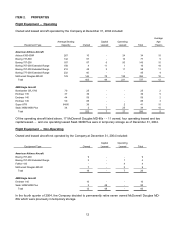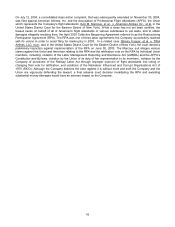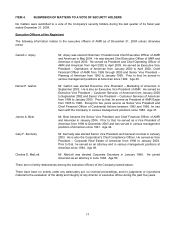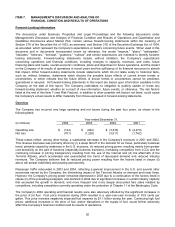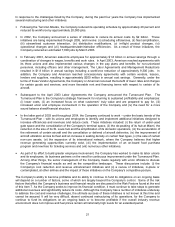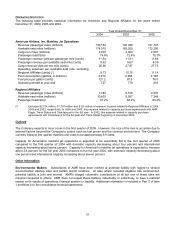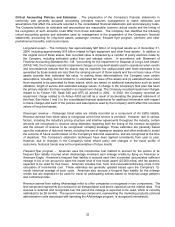American Airlines 2004 Annual Report Download - page 25
Download and view the complete annual report
Please find page 25 of the 2004 American Airlines annual report below. You can navigate through the pages in the report by either clicking on the pages listed below, or by using the keyword search tool below to find specific information within the annual report.
22
LIQUIDITY AND CAPITAL RESOURCES
Cash, Short-Term Investments, Restricted Assets and Deposits
At December 31, 2004, the Company had $2.9 billion in unrestricted cash and short-term investments and $478
million in restricted cash and short-term investments.
Significant Indebtedness and Future Financing
During 2002, 2003 and 2004, in addition to refinancing its $834 million credit facility (see discussion in Note 6 to
the consolidated financial statements), the Company raised an aggregate of approximately $6.0 billion of financing,
mostly to fund capital commitments (mainly for aircraft and ground properties) and operating losses. As of the date
of this Form 10-K, the Company believes that it should have sufficient liquidity to fund its operations for the
foreseeable future, including repayment of debt and capital leases, capital expenditures and other contractual
obligations. However, to maintain sufficient liquidity as the Company continues to implement its restructuring and
cost reduction initiatives, and because the Company has significant debt obligations maturing in the next several
years, as well as substantial pension funding obligations, the Company will need access to additional funding. The
Company’s possible financing sources primarily include: (i) a limited amount of additional secured aircraft debt (a
very large majority of the Company’s owned aircraft, including virtually all of the Company’s Section 1110-eligible
aircraft, are encumbered) or sale-leaseback transactions involving owned aircraft, (ii) debt secured by new aircraft
deliveries, (iii) debt secured by other assets, (iv) securitization of future operating receipts, (v) the sale or
monetization of certain assets, (vi) unsecured debt and (vii) equity and/or equity-like securities. However, the
availability and level of these financing sources cannot be assured, particularly in light of the Company’s and
American’s reduced credit ratings, high fuel prices, historically weak revenues and the financial difficulties being
experienced in the airline industry. The inability of the Company to obtain additional funding would have a material
negative impact on the ability of the Company to sustain its operations over the long-term.
The Company’s substantial indebtedness could have important consequences. For example, it could (i) limit the
Company’s ability to obtain additional financing for working capital, capital expenditures, acquisitions and general
corporate purposes, or adversely affect the terms on which such financing could be obtained; (ii) require the
Company to dedicate a substantial portion of its cash flow from operations to payments on its indebtedness,
thereby reducing the funds available for other purposes; (iii) make the Company more vulnerable to economic
downturns; (iv) limit its ability to withstand competitive pressures and reduce its flexibility in responding to changing
business and economic conditions; and (v) limit the Company’s flexibility in planning for, or reacting to, changes in
its business and the industry in which it operates.
Credit Ratings
AMR’s and American’s credit ratings are significantly below investment grade. Additional reductions in AMR's or
American's credit ratings could further increase its borrowing or other costs and further restrict the availability of
future financing.
Credit Facility Covenants
On December 17, 2004, American refinanced its $834 million bank credit facility, which was scheduled to mature
in December 2005. The total amount of the new credit facility is $850 million, all of which has been borrowed by
American. The new credit facility consists of a $600 million senior secured revolving credit facility, with a final
maturity on June 17, 2009, and a $250 million term loan facility, with a final maturity on December 17, 2010 (the
Revolving Facility and the Term Loan Facility, respectively, and collectively, the Credit Facility). American’s
obligations under the Credit Facility are guaranteed by AMR.


